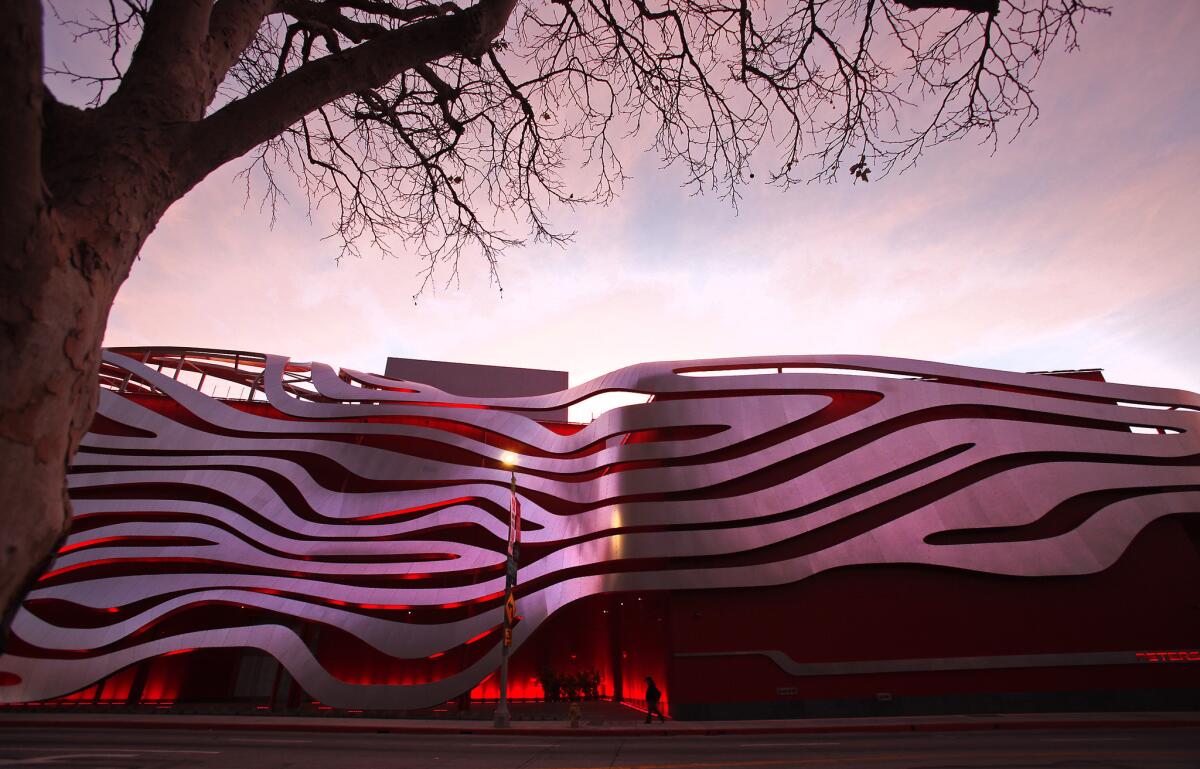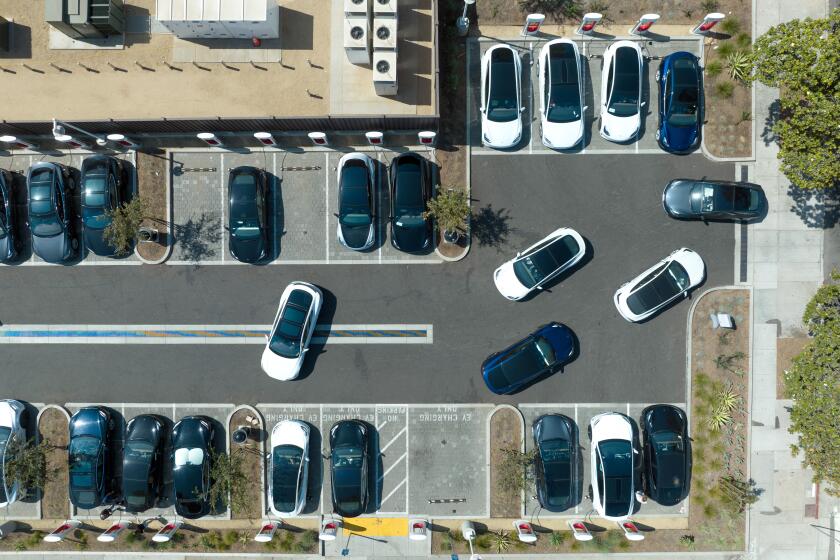Petersen Automotive Museum reopens with dramatic architecture, interactive exhibits

The Petersen Automotive Museum and its controversial facade glows at dawn in Los Angeles.
- Share via
After 14 months and $90 million in dramatic renovations, the Petersen Automotive Museum is poised to reopen.
Hitting a deadline that many inside and outside the organization thought impossible, the overhauled Wilshire Boulevard car-centric exhibition space will reopen to the public Sunday after its extended closure. The media got a preview Thursday.
The makeover seeks to make the dated museum more appealing to younger audiences with a trove of interactive technology — and to give all patrons ample reason to make repeated visits, which few did before the renovations.
The reimagined space — wrapped in stainless-steel ribbons over a “hot-rod red” skin that has divided critics — is bigger and bolder. Museum leaders aimed for a world-class institution on a Miracle Mile stretch that already includes such attractions as the Los Angeles County Museum of Art, Page Museum, La Brea Tar Pits and the future Academy Museum of Motion Pictures.
Museum boosters set out to join the league of such revered institutions as the Ferrari and Maserati museums in Italy; the Porsche, BMW and Mercedes-Benz museums in Germany; and Washington D.C.’s Smithsonian and National Air and Space Museums and the Musee D’Orsay in Paris.
“Our target was to be equal to — or superior to — those museums,” said Petersen board of directors chairman Peter Mullin, an avid car collector who operates the Mullin Automotive Museum in Oxnard. “We’re on Wilshire Boulevard at the entry point of Museum Row, in the car capital of the world, in California, which is the leading edge of transportation and alternative-fuel technology.”
The new structure features an additional floor and 12,000 square feet of gallery space — as much as 50% more, after third-floor offices were moved to the basement. It houses multiple galleries that will feature displays of 100 automobiles, 23 motorcycles, four scooters and one bobsled.
A “Precious Metal” exhibit in the Bruce Meyer Family Gallery features an estimated $120 million worth of silver-skinned American and European cars.
The Charles Nearburg Family Gallery contains an estimated $80 million worth of race cars.
A Hollywood-themed exhibit highlights cinema cars like a 1989 Batmobile, the Aston Martin DB10 featured in the James Bond movie “Spectre” and even the 2004 Pontiac Aztek from the TV show “Breaking Bad.”
French Art Deco cars in the Mullin-curated “Rolling Sculpture” collection include a 1939 Delahaye Type 165 and the famed 1936 Bugatti Type 57SC Atlantic, by some accounts the most valuable car in the world.
The underground “Vault” will display an additional 125 to 150 vehicles from the 300-plus pieces from the permanent Petersen collection.
Those responsible for the redesign say the new museum takes a more 21st century approach to the celebration of 19th and 20th century motoring technology.
“For the last 20 years, people were getting their information looking at cars with placards in front of them,” said museum curator Leslie Kendall. “Today, people learn by touching, by interacting electronically. We’re tying to keep up.”
Where once were only 10 flat-screen TV monitors are now a flotilla of interactive electronics, including 47 Panasonic projectors, 35 interactive touchscreens and 25 LED monitors, 291 three-dimensional displays of engines and scale models and several enormous projection walls that will better capture the excitement of motoring and automotive art.
The most important goal, Mullin said, was to lure return visitors to the museum. When he became chairman, he asked staff members for statistics on attendance and was told that 70% of visitors were making their first trip to the museum.
“Isn’t that wonderful?” Mullin recalled staff telling him.
He responded: “It’s the worst statistic I ever heard.”
It meant less than a third of visitors found any reason to return to the museum once they had seen it. Mullin wants to see the vast majority of visitors come back for more.
The new museum also features 10 Microsoft Xbox Forza driving simulators, where visitors can race against virtual professionals or against one another. To get cars into and out of exhibit spaces, the Petersen now has a car elevator, said to be one of the largest in Los Angeles, capable of lifting 14,200 pounds from street level to the top floor.
The museum’s motorcycle collection, curated by Petersen board member and treasurer Richard Varner, is an attempt to be “broad but credible.”
A gallery displays a two-wheeler representing the best of every decade in motorcycle history -- a 1903 Thor Camelback, a 1922 Brough Superior, an L.A.-built 1936 Crocker V-Twin, up to a supercharged, 300-horsepower Kawasaki Ninja H2R to represent the most extreme current engineering.
“The challenge was to have something where people wouldn’t say, ‘Oh, it’s just a bunch of motorcycles,’” said Varner, a collector whose own Triumph Bonneville T120R represents the collection’s 1960s British bike era. “We’ve got a significant bike from every decade in motorcycling’s 100-year history.”
Mullin said the fundraising campaign to support the construction and future operation of the not-for-profit Petersen had collected or received pledges for $94 million, sufficient to pay for the new building and keep intact a $34 million operating endowment.
“We are on time and on budget,” he said before, flanked by Petersen board members, he used a pair of large scissors to cut the opening-ceremony ribbon.
More than 90% of the money came from private individual donors, Mullin said — a lot of it from Petersen board members — with the balance coming from automobile companies and after-market parts suppliers. None of it, he said, was public money.
“There was zero government money,” he said. “I didn’t actually consider government funding as likely to happen, so we didn’t pursue it.”
As for the controversial, “Hey, look at me!” exterior, car collector and former Petersen chairman Bruce Meyer said, “Before, nobody knew we were here. Now, nobody’s ever going to drive by this building and not know we’re here.”
Twitter: @misterfleming







